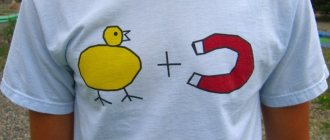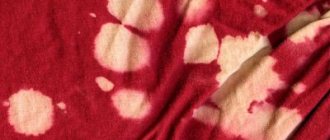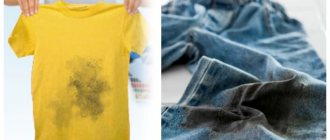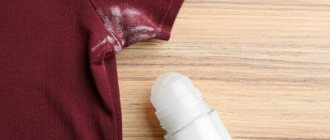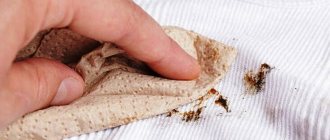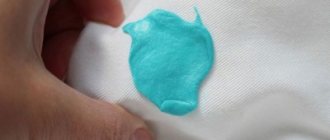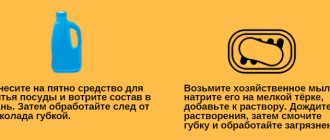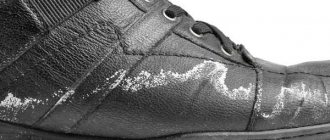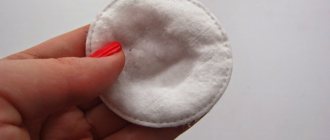Home / Clothes care
Back
Published: 07/12/2020
Reading time: 7 min
0
15
- 1 Traces of hot glue
- 2 Tips: what you should never do
- 3 Special cleaners
- 4 Wood glue
- 5 Hot glue
- 6 Epoxy
Tips: what you should never do
It will be great if you managed to quickly and promptly clean a glue stain from clothes or linen. However, here it is worth considering some points that can help keep things in good condition and prevent damage.
- There is no need to pour solvent onto fabric without first testing for interaction. It is better to test this on an inconspicuous area of matter first.
- It is strictly forbidden to wash some types of glue - this will only enhance the adhesion effect and the adhesive mass will be virtually impossible to remove. The item will be completely ruined.
- After applying a cleaning agent to the fabric, there is no need to leave it there for a long time.
- If glue comes into contact with delicate fabric, extreme caution must be used and a more gentle or gentle cleaning option will be used that will be best suited for this type of fabric.
If none of the methods described above helped remove the sticky substance, you can try going the other way and purchasing a special cleaning agent at a hardware store.
Having accurate information about which chemicals have a destructive effect on certain adhesive components, you can easily remove glue from clothes.
When using cleaning products, it is important to always remember the product and not allow a hole to appear instead of a stain.
It is easy to remove fresh traces of PVA glue from clothes by washing with laundry soap. Or place the soiled part of clothing that is not afraid of high temperatures, with the wrong side under running hot water. After 20-30 minutes the glue will come off the fabric.
An old stain on cotton, linen or denim fabrics will go away if you wipe it with a cotton cloth soaked in alcohol.
A stain from PVA glue on a suede product must first be held over steam for 5-7 minutes, and then carefully remove the dirt with a paper towel or napkin soaked in ammonia.
The freezing method is also suitable for delicate fabrics. Place the clothes in the bag in the freezer for 1-1.5 hours. Then carefully remove the glue from the material with your hands, which has become brittle from the cold.
Freezing
Some types of hot melt adhesives are unstable at low temperatures (see instructions). In the cold they become brittle, break down and crumble. The item from which the hot-melt adhesive is being removed must be placed in the freezer and waited for some time. Under the influence of negative temperatures, the glue will collapse and can be separated by scraping and shaking.
The method is not very convenient. Not every item can be placed in the freezer. Many hot melt adhesives are resistant to negative temperatures.
For example, ADTEK adhesives are guaranteed to work down to -20℃ and are therefore used for labeling frozen foods.
Special cleaners
To quickly and efficiently remove hot-melt adhesive from the surface and clean equipment, special cleaners are used. On the Mebax company website, such materials can be viewed in the “Accessories” section. There are hot and cold hot melt glue cleaners. Cleaners are made from organic natural raw materials. They have a citrus smell, signaling the presence of cleaning product vapors in the air.
The cold cleaner is designed to remove hot-melt adhesive from work surfaces and tools. It is applied to hot melt glue using a rag or rag. Within a few minutes, the adhesive destructures and is then removed mechanically.
To clean equipment in inaccessible places (internal space of the heating chamber, internal walls of hoses), a hot-applied cleaner is used. Removal of adhesive residues is carried out by recirculating a hot cleaner through the melting chamber and adhesive lines.
Qualified advice on organizing cleaning of glue equipment and maintaining it in good condition can be obtained from the managers of the Mebax company.
We invite you to read: The washing machine takes on water and stops: common causes of breakdowns and repair methods
Why is it difficult to remove from fabric?
Any glue, penetrating into the fabric, compacts its structure and spoils its appearance. Over time, a hole may form in place of the dried stain. The substances contained in the glue destroy the fibers of the fabric. Stains that appear on clothing are difficult to remove. It's easier to remove them while they're fresh.
“Titan” and “Moment” products have the maximum degree of adhesion. They are resistant to moisture, high temperatures, and frost-resistant. Water-based adhesives are less stable. While the stain is fresh, it can be easily removed with water and washing powder.
Wood glue
Universal solvents are compounds that help get rid of all types of glue, regardless of their origin. They must be used carefully, since they are based on caustic substances.
An effective, inexpensive and effective remedy is “Super Moment Anti-Glue”, which
costs about 100 rubles
per package. It copes not only with removing adhesive stains from Superglue, but also with other adhesives: PVA, contact adhesives, etc.
The product has a gel consistency, thanks to which it does not spread over the surface of the fabric and does not stain clothes.
- Place a paper napkin under the back of the soiled item.
- Apply the composition to the stain.
- Cover it on top with another napkin and leave overnight.
- Put away napkins, wash things.
Other universal compositions include:
- Acetone. The substance has a pungent odor, so it should only be used in areas with good ventilation. To avoid damaging the fabric, first test the product on an inconspicuous area. Moisten a cotton pad with acetone and use it to treat the stain. You cannot leave it on the fabric for a long time.
- Nail polish remover. It contains acetone, but in a lower concentration, so when removing traces of persistent glue, it can be left on the item for 10-15 minutes. Remove dirt using a stiff brush, for example, the back of a sponge.
- Petrol. It has a fatty base and a pungent odor. Therefore, it is recommended to use it outdoors. The composition is applied to gauze folded in several layers, which is used to systematically treat stains on clothing.
- Dimexide. This is a pharmaceutical solution that is used for medicinal purposes. To remove sticky traces you will need a 99% concentrate. To remove fresh stains, simply apply Dimexide to a napkin. It wipes away the dirt until it disappears completely. If the glue has dried, make a lotion, keeping the solution on the fabric for no longer than 5-15 minutes.
All universal compositions are capable of dissolving not only glue molecules, but also paint. Therefore, when processing colored fabrics, you need to test the selected product on an inconspicuous area.
Soda and laundry soap
- Add two tablespoons of baking soda to one liter of warm water.
- Wash the glue stain well with regular laundry soap.
- Dip the soaped part of the clothing into the soda solution and leave for 40-50 minutes.
- Wash by hand or machine.
For suede items you need to use a special shampoo or soap.
Washing powder
- Dissolve 200 g of powder in 4 liters of warm water.
- Leave the soiled item in this solution for 3 hours.
- Afterwards, squeeze it well and try to remove the dirt with the hard side of a sponge or a medium-hard toothbrush.
Or rub the stained area with laundry soap and soak for 4-6 hours in warm water. After washing.
Office glue from clothes is removed with laundry soap. Rub the heavily soaped stained area with your hands or a brush. Afterwards you have to wash your clothes by hand or in a washing machine.
Wood glue can be removed from clothing by soaking it or the stained part in cold water for a full day (12 hours). This is followed by machine or hand wash. Remove remaining stains with a brush and wash again.
It can also be removed with laundry soap. Wash the stained area well and soak for half a day in warm water. Afterwards just wash.
Stationery glue, or it is also called silicate glue, due to its widespread use, is one of the most common types of adhesives. It is used almost everywhere - in kindergartens, schools, organizations, companies and firms.
Removing such a sticky mass from any surface will not be difficult. All you need for this is laundry soap.
We suggest you familiarize yourself with How to remove the smell of diesel fuel from clothes and inside the car
The area stained with glue should be generously lathered with soap, then lightly rubbed with a brush or just with your hands. Next, the item will need to be washed in a washing machine or by hand, as is always done.
How to easily remove glue from clothes at home
Glue sticks are constantly used by children at school to make all kinds of crafts and paper applications.
Getting rid of this type of sticky substance is quite easy - just generously soap the stain with laundry soap, rub a little and rinse with lukewarm water. After this procedure, the clothes are sent for washing.
- If the bustylate layer is thick enough, you can first try to scrape it off with a sharp object. This way he can get wet faster.
- Warm water or vinegar can give you good cleaning results. Using a swab moistened with the solution, you need to continue wiping the area of contamination until the glue stains completely disappear.
- If complete cleaning is not possible, you can try using denatured alcohol. The material soaked with it is left for 30...40 minutes, after which the substance is washed off with warm water and washing powder.
Removing glue from clothes and removing stains
In restoration shops and carpentry workshops, the main means for gluing wood materials is wood glue. Workers in such industries very often have to deal with blots from such glue. It is not at all easy to remove traces of this substance from things, but it is still possible.
- Clothes stained with wood glue are soaked in a basin of cold water. After 12 hours, the item should be washed in a washing machine at maximum water temperature.
- If noticeable stains remain after washing, the area should be scrubbed with a brush. Then wash again.
- Fresh marks are removed as follows: the product must be soaked in warm water for 3…4 hours. After this time, it goes into the washing machine to be washed.
- Old stains must first be softened, and then the adhesive mass must be carefully scraped off with a knife. The places where the blots hit can also be rubbed with a brush. At the end of this operation, rinse the item in hot water.
... and in conclusion or some conclusions
There are a sufficient number of ways to remove traces of glue from rhinestones on clothes. Regardless of which method will be used in practice, it is very important to follow a clear sequence of all stages of the process.
Getting rid of superglue stains
It is characterized by rapid drying and reliable bonding of almost all surfaces. Stains or excess stains can be removed using anti-glue, strong solvents, vinegar, citric acid, nail polish remover, freezing and heating.
Anti-glue, refined gasoline, paint thinners
Anti-glue can be purchased at building materials stores. Apply 1-2 drops to glue marks and after 5-10 minutes wipe with a paper napkin.
White spirit, acetone, and kerosene are used on non-colored cotton and linen fabrics. Their use on wool, velvet, silk and synthetic fabrics is prohibited. Thin synthetics can dissolve under their influence.
- Soak a soft cloth with one of the selected substances.
- Wipe off dirt with it.
- Wait 20-30 minutes.
- Wash the item as usual.
It is allowed to repeat the procedure no more than 2-3 times for an old stain. If most of the dirt has been removed, it is better to try to wash off the glue by hand. This will prevent tissue damage.
Note: Acetone is effective, but can sometimes leave yellow stains.
Vinegar
Suitable for removing glue stains even from delicate fabrics, but is contraindicated for denim.
- Dilute one tablespoon of vinegar in warm water (one glass).
- Moisten a soft cloth in the resulting solution and place it on the adhesive trace.
- After 20-30 minutes, remove the dissolved glue with a napkin. You can soak the product in this solution for half an hour.
- Then wash as usual.
Nail polish remover/acrylic nail softener
- Soak a soft cloth with one of the selected products.
- Treat the part of the item stained with superglue.
- After 20-30 minutes, clean the dirt with the hard side of a dishwashing sponge.
- Wash the item as usual.
When working with delicate fabrics, it is better to use an acetone-free liquid.
Dishwashing liquid will help get rid of greasy stains that may remain after removing the adhesive residue.
Exposure to high or low temperatures
There are two effective ways:
- From the wrong side of the product, through gauze or soft fabric, apply a hot iron to the superglue mark for a split second. After half a minute, apply the iron again. Repeat two to three times. Remove remaining adhesive mechanically - rub with your hands, a toothbrush or the hard side of a sponge.
- Keep the soiled clothes in the freezer for 1-1.5 hours. Pull out and rub the glue stain with your hands or a toothbrush with medium-hard bristles. When frozen, the glue crumbles and easily comes off the fabric. Wash clothes. It will take several washes to completely remove the stain. The freezing method is also applicable for delicate fabrics (organza, silk, viscose).
Citric acid, dimexide, white, powder
Here are a few more ways to remove superglue stains from clothes:
- Dissolve citric acid (20 g) in warm water (half a glass). Apply the resulting solution to the adhesive marks with a soft cloth. After 5-10 minutes, rub the stained area with a hard sponge and wash the item.
- The nail file is suitable for removing glue from suede or leather products. It is enough to move it with light circular movements over the contaminated surface.
- Dimexide (a medicine for the treatment of bruises and purulent wounds sold in pharmacies) allows you to get rid of glue stains from any type of fabric. Use a soft cloth soaked in a solution of dimexide (2 tablespoons) and room temperature water (half a glass) to wipe the contaminated areas. After 10-15 minutes, wash the item.
- Whiteness applies to white things. Apply the product to the adhesive stain and rub it with a cotton cloth. The sponge will not work; its small fibers will cling to the glue.
Hot melt adhesive
Hot melt adhesive is not easy to remove from clothing. The heating or freezing method is absolutely not suitable.
The thing is that with repeated cooling or heating, hot melt adhesive does not lose its properties, does not dissolve, but, on the contrary, penetrates even deeper into the fibers of the fabric, gluing them together. Ordinary solvents are also powerless in the fight against hot-melt adhesive stains.
You can remove hot-melt adhesive with a special non-acetone spray Ninelle or Flux OFF cleaner (designed for cleaning boards). The composition is applied to the stain and left for the time specified by the manufacturer (usually no more than fifteen minutes). After which the glue is easily cleaned off without any residue.
It is important to strictly follow all recommendations of the cleaner manufacturer. Otherwise, the product may be completely damaged.
We know how to clean and clean, wash and wash, wash, wash and scrub!
How to remove hot melt glue? If you use thermoplastic glue (hotmelt glue), no matter how carefully you use it, sooner or later you will still accidentally drip melted glue onto your clothes. Is there a way to remove hot melt glue from clothing without damaging the fabric?
Hot-melt adhesive in its normal state is a solid substance. Since it is applied in a molten liquid state, it can penetrate through the threads of the fabric before it hardens. The deep penetration of hot-melt adhesive into the fabric structure makes it difficult to remove. There are several ways to remove hot melt glue from fabric. It may take you a few tries to find the right solution for your specific fabric type.
Safety regulations
The gun operates from an electrical network, and the default current is potentially dangerous to life and health. It also gets very hot: the melting point can reach 200 degrees. If hot glue drips onto your skin, it will not cool immediately and will cause a burn. Therefore, before work, it is better to wear gloves and goggles, especially if you are gluing or decorating parts at a height higher than your height.
During breaks between stages of work, the gun is left on the stand with its nozzle down. It is better to put a piece of fabric or paper under it, which you won’t mind throwing away, since the frozen polymer will remain on it. Since the stand will remain clean, and drops of glue will not spoil the tabletop and floor.
When the device is warmed up, do not reach into its body with sharp metal objects to remove any remaining consumables or change its position. Do not touch the nozzle while the gun is on. When cooled, the polymer is not harmful, therefore it is approved for use in interior decoration and decoration of children's toys.
To make using a glue gun as safe as possible, it is not recommended:
- Work in a room with high humidity.
- Glue in a poorly lit place.
- Connect to a network with sudden voltage surges.
- Allow children and untrained adults to approach the area of application.
- Tug or pull on the cable.
All of the above actions pose a risk of failure or accident.
How to remove from shoes
The surface of patent leather shoes is sensitive to mechanical damage. Glue stains are removed from it using medical alcohol wipes and salt. The contamination is first “salted”, then covered with a cloth soaked in alcohol. After a couple of hours, the compress is removed. Clean the surface with a damp sponge. The glue stain on the sneakers is heated with a hairdryer and removed with a napkin. Faux leather shoes are cleaned with a warm (30 °C) solution:
- soapy water - 1 l;
- baking soda - 1 tsp.
The liquid is applied to the stain area with a sponge. The glue is removed after 15 minutes with a soft cloth. Suede shoes, boots, clean with solvents:
- acetone;
- ammonia;
- gasoline.

